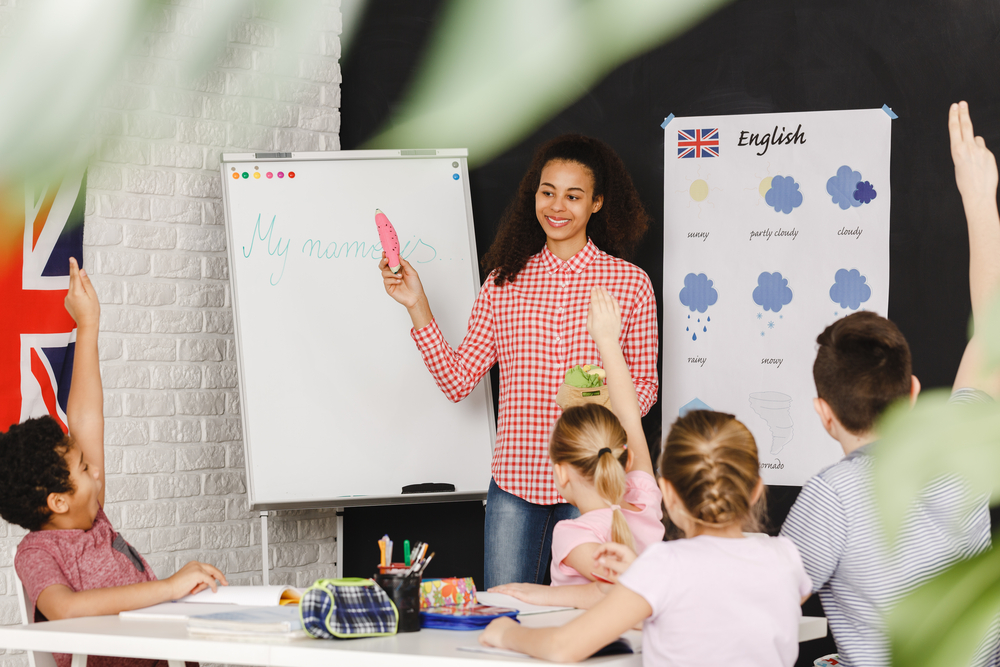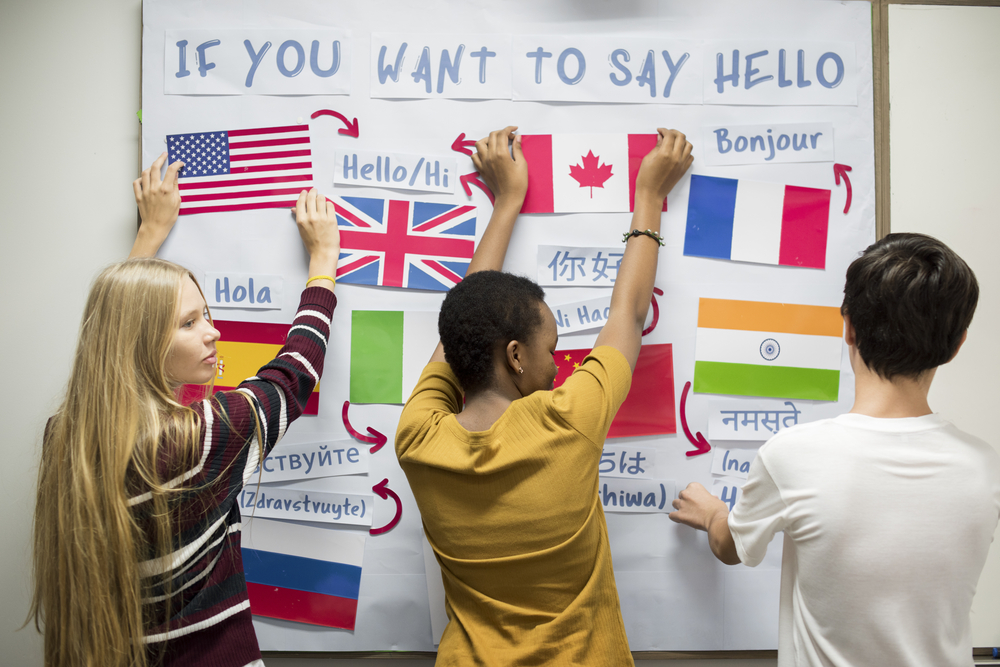
13 Essential ELL Strategies to Support Students (with Classroom Examples)
Ever noticed that, even with a well-thought-out lesson, some students grasp the concepts straight away while others still struggle?
This is pretty common in classes for English Language Learners or ELLs, and it usually has to do with students’ individual learning strategies.
Some may have already cultivated their own unique ways of studying. Others may have never given this a second thought.
The good news is that you can help them.
By familiarizing yourself with the different teaching strategies below, you can give effective ELL support and teach your students how to learn.
Contents
- 1. Consider Both Content and Vocabulary
- 2. Help Your Students Make a Study Plan
- 3. Encourage Self-monitoring
- 4. Ask Students to Reflect on Their Progress
- 5. Build on Prior Knowledge
- 6. Take Advantage of Language Transfer
- 7. Use Predictions to Make Topics Relatable
- 8. Allow for Language Substitutions
- 9. Add Visuals for Clarity
- 10. Practice Scaffolding
- 11. Do Roleplaying Activities
- 12. Get Your Students to Notice Rules
- 13. Classify and Organize Information
Download: This blog post is available as a convenient and portable PDF that you can take anywhere. Click here to get a copy. (Download)
1. Consider Both Content and Vocabulary

With ELL lessons, you should always take these into account:
- What content are you going to teach?
- What kind of vocabulary would be appropriate for your students?
There are a few things to remember with teaching vocabulary explicitly:
- A simple and clearly understood definition must be provided. It’s often helpful to introduce the word using some sort of visual.
- Vocabulary should be revisited and reviewed multiple times.
- Vocabulary must be taught and used contextually.
- Students must be actively involved in using the vocabulary.
Example:
If you’re teaching about the solar system, you must determine what exactly it is that you want to teach. You decide you want to teach how many miles each planet is from the sun.
Next, you’ll think about your language objective. ELL students aren’t likely to be as familiar with the vocabulary associated with solar system compared to native speakers. Specific vocabulary must be explicitly taught.
It can be fairly simple to determine which words might be appropriate for your language objectives. Just choose words that are significant to the lesson. In this case, you might select the words solar system, miles and planet to explicitly teach.
2. Help Your Students Make a Study Plan

Teaching your students how to plan their learning is essential, as it sets their expectations and gives them goals to reach.
Learning in a foreign language is incredibly difficult, and it can sometimes seem to ELL students that there are simply too many gaps in their language knowledge to grasp a subject.
However, if they plan to do one manageable task at a time, they can immediately see progress.
Example:
Imagine that you’re giving your students a novel or short story that they’re required to read, as well as a dictionary.
Now, students will likely begin to look up every single word that they don’t recognize. This leads to broken reading and discontinuity in their comprehension.
However, if students plan to read an entire page or paragraph to get an overall grasp of the content before looking up any words, they’ll likely have heightened comprehension, and they might be able to guess at unfamiliar words based on the context.
This is an example of planning on a small scale, but this can also be applied to more long-term learning goals.
3. Encourage Self-monitoring

Monitoring progress might come as second nature to teachers, but students haven’t necessarily been taught to independently monitor their own learning.
Once they learn to do this, it can help accelerate their learning massively as they feel personally responsible for their own progress. ELL students can sometimes feel powerless in an environment where they aren’t communicating in their first language, but this helps them take back some of this control.
Example:
Why not give your students a copy of your long-term plan for the week, month or even year ahead?
Spend some time walking them through exactly what topics you’ll be covering and what’s expected of them at each stage. Better yet, encourage students to continually refer to this outline by asking them periodically what stage they should be at, what topic is being covered next and whether or not they feel they’re meeting their goals. This way, students can self-monitor their progress.
If you use graphs and charts to track student progress, you can even share this data with your students on an individual basis.
Research has suggested that traditional, teacher-led progress monitoring isn’t always effective, because students’ thoughts and feelings about their personal progress aren’t factored in. Student self-monitoring solves this problem!
4. Ask Students to Reflect on Their Progress

No matter what subject you’re required to teach your ELL students, it’s vital that they evaluate their own progress. Beyond tracking what they’ve learned, encourage them to think about what worked and what didn’t for them.
Getting your students to self-evaluate can seem like a rather daunting and time-consuming task. However, it can be implemented into your lesson plans easily, and, once your students start doing it more often, it should become a habit.
Example:
You can start by asking students to reflect on their performance after small tasks.
For younger students or those with extremely limited English, ask them to evaluate how they’ve performed based on a numerical scale. This will encourage them to address gaps in knowledge so that they can rate themselves higher in the future.
For more advanced students, you could ask students to write two short sentences addressing “What went well” and “This would have been even better if…”.
If time allows, you can go over these sentences yourself to help students address any recurring issues. Make sure they’re keeping track of these in the same notebook or folder, preferably one which they keep in your classroom so it never gets misplaced!
This guide by the University of New South Wales suggests methods for student self-assessment and self-evaluation, including reflection activities and blogging.
5. Build on Prior Knowledge

Prior knowledge influences how a student interprets and organizes new information.
Think about an American wedding. You’ve probably attended one, or at least seen one on TV. If a friend were to tell you about a recent American wedding she attended, you’d have lots of prior knowledge influencing your perception of the event, and you could imagine it easily.
But if a friend were to tell you about a wedding based on another country’s traditions that you haven’t experienced before, it would be more difficult for you to recall details. Your lack of prior knowledge would dictate the need for more cues and reference points.
Because of this, it’s helpful to be familiar with what your students already know about a topic.
What connections can be made? What details are missing? Are there some misconceptions that may need to be addressed?
Example:
Prior knowledge can be activated in a number of ways. Just presenting a visual—a picture or an object—can really start a student’s wheels turning.
Once the wheels are turning, it’s time to start asking questions:
- What do you know about this?
- Tell me about some experiences you’ve had with this.
- How does this make you feel and why?
- Have you ever read anything about this? If so, what?
Graphic organizers are also helpful for classifying information. Brainstorming, webbing and creating KWL charts are all methods of working with graphic organizers that can activate prior knowledge.
Hopefully, by this point, you’ll have a pretty good idea of your students’ understanding and experiences regarding the present topic. Now you know where to begin.
Use their experiences to help them make connections. Fill in any blanks that may be missing. Pick up where their experience leaves off.
6. Take Advantage of Language Transfer

Language transfer is a term used to describe the influence of a language learner’s first language on their acquisition of a second language.
You’re probably already aware of the similarities between some words in English and other European languages if you’ve studied them. The French words horrible, terrible and excellent mean exactly what you’d expect them to mean in English, making my life as a high school French student much easier!
However, language transfer can also lead to misunderstanding due to something known as “false friends.” This is when two words are so alike that students assume they mean the same thing in both languages, but in fact, there’s a subtle difference.
Imagine, to the despair of many students, discovering that the French librarie doesn’t mean “library” but instead means “bookstore,” and the French for library is actually bibliothèque!
Even then, these false friends can still help to create memorable vocabulary lessons.
Example:
Encourage your students to examine words and grammar patterns closely to see if they notice any similarities with words in their own language.
You can start by providing the words initially, to help students realize that they’re able to make language transfer connections in certain situations. Soon enough, they shall begin to make these connections on their own without prompting.
However, encourage dictionary work when needed, to avoid misunderstandings caused by false friends.
7. Use Predictions to Make Topics Relatable

Making predictions can seriously enhance student comprehension.
Instead of jumping straight into a lesson, you can make a topic more approachable by asking students to predict what will happen in a related everyday situation. This gets them to recall what they already know about the topic and generates related vocabulary, which acts as a warm-up.
Example:
You can provide your students with a title, picture, question or even a short discussion related to the task ahead.
Imagine, for example, you’re teaching a science lesson about plant growth, but you’re worried that the scientific language will prove too intimidating for your ELL students. Something as simple as presenting students with a seed being planted, and asking them to predict what will happen to the seed over time, can be extremely effective in this situation.
Their prediction could come in the form of a storyboard illustrating growth or in a written description, or both. Students should be fairly confident that their prediction is correct, based on their prior knowledge.
Then, when you introduce more scientific vocabulary, you and your students can use their predictions as references to put the concepts in context.
8. Allow for Language Substitutions

When students feel unable to express themselves, they can be encouraged to find alternative ways of using the language to get a similar meaning across. You can encourage substitutions at both word level and sentence level.
Example:
During an upcoming history lesson, you might require students to write an account of the American Civil War. In order to prepare them for this daunting task, you can encourage students to collect their information online, perhaps creating a timeline of events.
If your students only collect information from one source, they’ll only have encountered one way to describe events, which they might try to recreate exactly when they write.
However, if they create timelines using different written sources, or they have access to other students’ timelines from different sources, they’ll have various ways of describing the same events. By widening your students’ language sources, you can help them to substitute language where they would otherwise struggle to express themselves.
At the vocabulary level, you can also give students access to resources such as thesauruses and encourage them to use these in their own time. Additionally, there are plenty of online resources such as this one for synonyms and antonyms.
9. Add Visuals for Clarity

As we know, some students prefer to learn with visual aids.
Imagery is particularly useful for ELL students as they can struggle to really connect with the language when it’s presented on a page or in the spoken word. Imagery helps to solidify meaning and reassure students that they are following the language correctly.
Example:
The great thing about visual aids is that you can encourage their use in just about any situation.
Want to teach past perfect tense in English? Use a timeline to help students understand how the event is situated in time.
Want to teach some new vocabulary? You can get creative with flashcards or illustrations. For instance, FluentU has vocabulary flashcards that include an image, sentence examples with audio, and even video clips that you can show to your students.
Reading a Shakespeare play in English? Encourage your students to create their own storyboard as they progress in the plot, using great websites such as StoryboardThat.
Another effective way to use visuals would realia. Realia are objects from real life used in the classroom for instructional purposes. A physical experience with an object, such as touching, smelling or tasting, helps solidify a student’s comprehension of a new word or concept.
In addition to using imagery to help remember parts of the language, you can also invert this strategy by, for example, beginning with a picture and asking students to describe it. This encourages students to really dig deep for adventurous and ambitious vocabulary, and it’s a great strategy to use before writing.
10. Practice Scaffolding

Scaffolding was originally coined by psychologist Jerome Bruner in the mid-seventies. It really just refers to the belief that, in the beginning stages of instruction, a student will need more support to be successful. As the skill level is strengthened, the support can be methodically eliminated until the student is comfortably succeeding on their own.
Scaffolding was actually how I learned to ride a bike.
First, my then-boyfriend-now-husband showed me how to ride a bike with slow, exaggerated moves. When it was my turn, I hopped on the seat and performed the movements with his help, like a six-year-old. After several minutes, he let go, and I could already ride a bike successfully on my own.
You can think of scaffolding as an I do, We do, You do theory of teaching. Scaffolding is effective with ELL students because it introduces skills and tasks in a slow and manageable manner.
It’s easy to become overwhelmed when learning something new. This can lead to a lack of confidence which could eventually shut down the learning. Through scaffolding, a student builds confidence while mastering a skill.
Example:
So, what does scaffolding look like specifically for the ELL student?
Just like the bike riding experience, modeling can be the foundation of scaffolding. Instead of reading instructions, sometimes it’s more helpful to watch someone do a task before it together and, ultimately, doing it yourself.
Applying this to an ELL class, you can guide your students through fill-in-the-blanks exercises first while explaining your reasoning, then work up to having them create their own sentences without your guidance.
Visuals can also be used as a form of scaffolding.
When introducing new vocabulary, it’s beyond helpful to have a visual representation of the new words. As the students become more familiar with the language, the visuals can be removed. Soon they’ll be recognizing words and reading them all on their own.
11. Do Roleplaying Activities

Cooperative learning is always beneficial in the ELL classroom since working with peers creates a low-pressure, confidence-building environment. One of the best activities for this would be roleplaying.
A favorite of drama teachers, roleplay needn’t be confined to the more theatrical subjects where your ELL students are concerned! Using roleplay helps your students use the target language as they would do in real life—communicating with others.
ELL students are sometimes hesitant to practice speaking the language out loud in the classroom, for fear of making mistakes or seeming incompetent. Whenever roleplay is used in the classroom, you should try to ensure that you’ve covered the language and background information that your students would need for a roleplay scenario.
Example:
Why not try using video? Imagine you’ve been looking at a recorded political debate, either as a language focus or in a specific subject you might teach, such as politics. When you’re confident that your students are familiar enough with the type of language used in a debate, you can set up a classroom debate about a subject of the students’ choosing.
You could even implement an earlier-taught learning strategy such as self-evaluation before and after the task. This gets students to measure how confident they were about the language before and after, hopefully showing them how effective the roleplay might be for them.
12. Get Your Students to Notice Rules

When students are taught a rule, let’s say a grammar rule, they can immediately apply it to the language they already know. After a time, they become so familiar with the rule that it becomes second nature. At least, that’s the theory.
But what if they forget the rule? Or what if the exceptions to that rule are so numerous that they begin to over-apply it and get even more confused and frustrated?
Well, Richard Schmidt’s Noticing Theory (1990) suggests that, if students learn rules by noticing them rather than being told them, they’re more likely to remember the rule.
Example:
When I was learning French in high school, I was given lists and lists (and more lists) of verb conjugations to learn. I would write them out, over and over, until my writing hand hurt and my brain was fried. A less-than-inspiring learning strategy.
Why not give your students the tools to notice conjugations for themselves? And in context!
A very simple example is this great little song from Rockin’ English Lessons:
It uses extremely simple vocabulary with accessible visuals, and it incorporates all the present simple verb conjugations of the verb “to be.”
For more advanced learners, keep an eye out for other songs and reading passages where the characters repeat the same actions, so that students can notice the correct form of the verbs by themselves!
13. Classify and Organize Information

Classifying is especially useful for ELL students who have to learn about various subjects in a language different from their own.
Classifying involves grouping information together in a way that will help students understand and remember it. The great thing about classifying is that it’s very flexible–your students can do it in whatever way works best for them, depending on the topic.
Example:
Let’s say you’re teaching a geography lesson about countries of the world. Perhaps, if your student is a visual learner, they would benefit from maps. They might focus on pictures of the food, style of dress or traditional customs in each country.
If they enjoy planning, they can jot down what they currently know about each country and then set goals based on what they would like to find out. Perhaps they’d like to classify vocabulary based on how confident they are with it, using categories like “very confident,” “not so sure” and “need to learn.”
Whichever way you use classifying, it’s a great tool to help organize your students’ thoughts and give them control of how they learn.
So, there you are!
13 superb learning strategies for you to teach your ELL students to help them become confident learners in what is often a very challenging and frustrating learning environment.
Good luck!
Download: This blog post is available as a convenient and portable PDF that you can take anywhere. Click here to get a copy. (Download)



